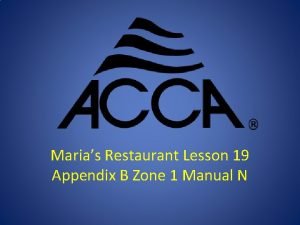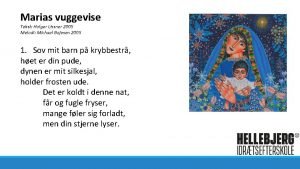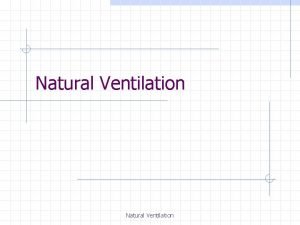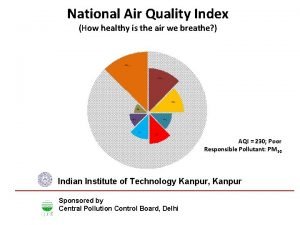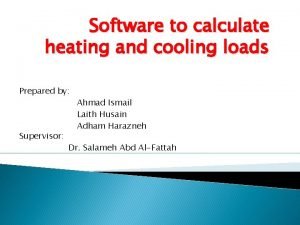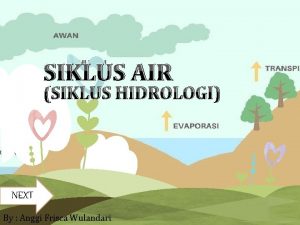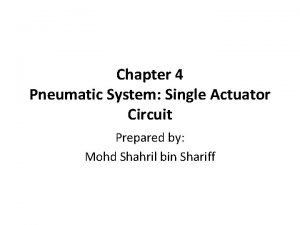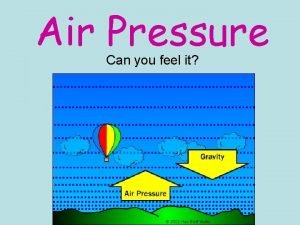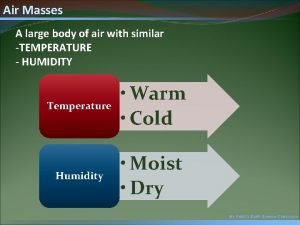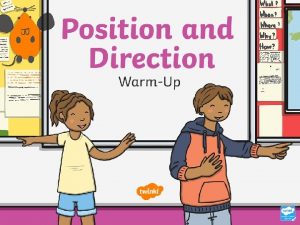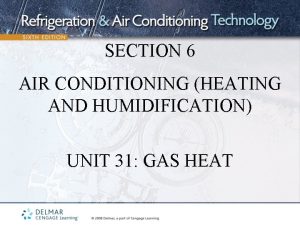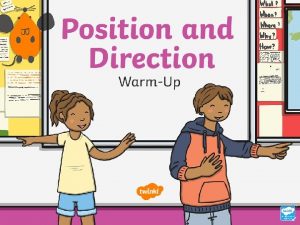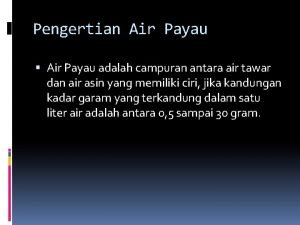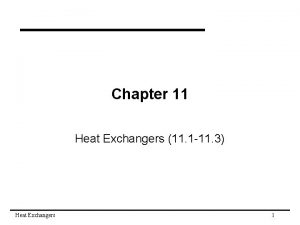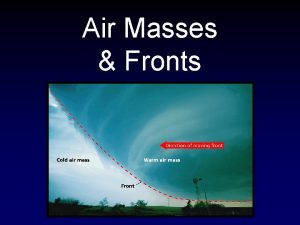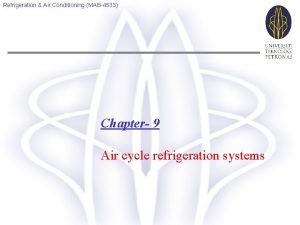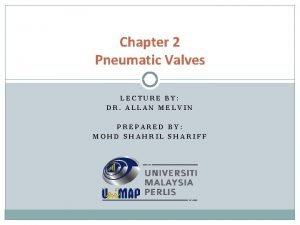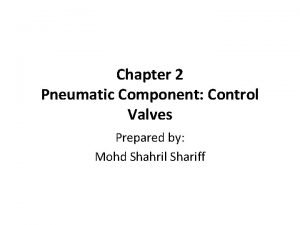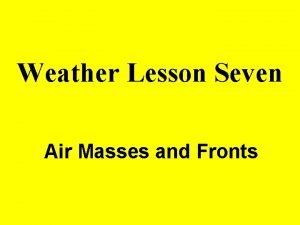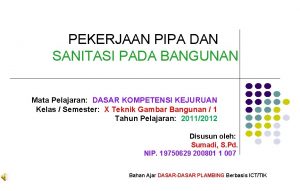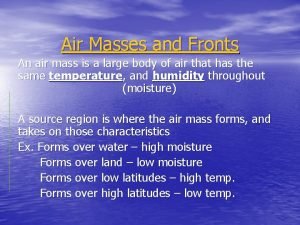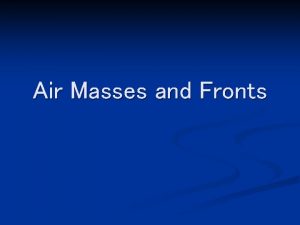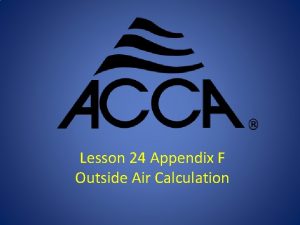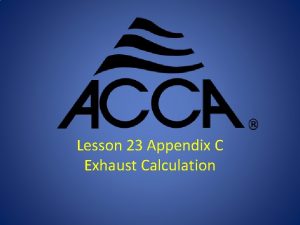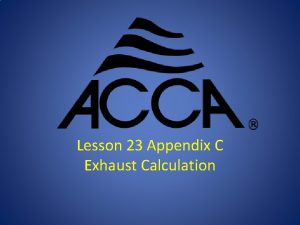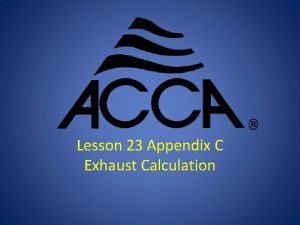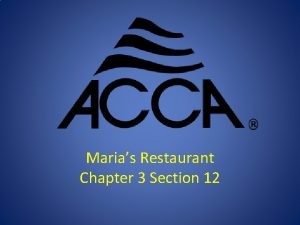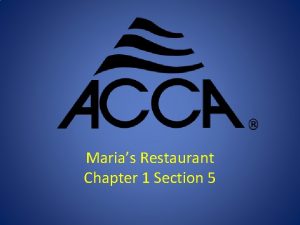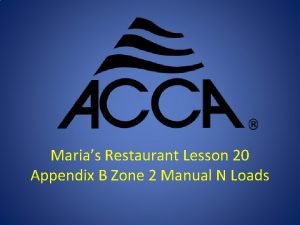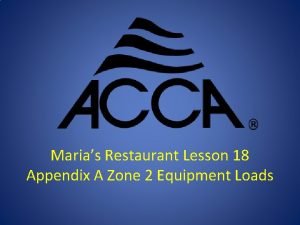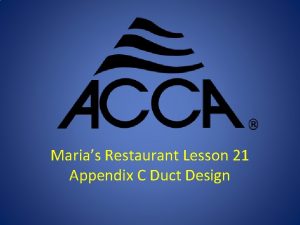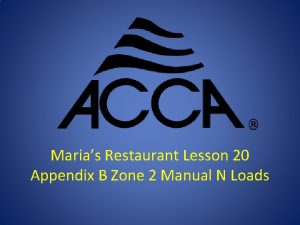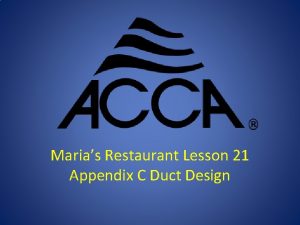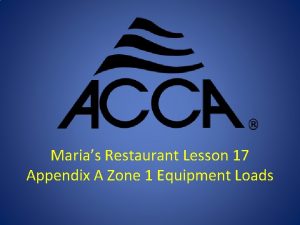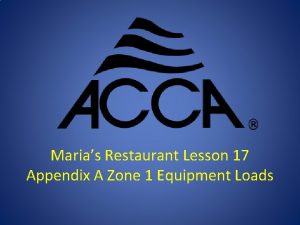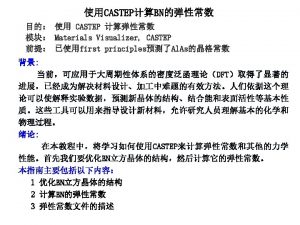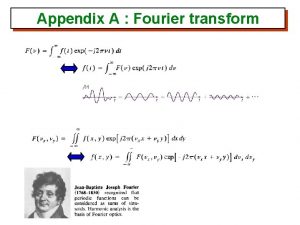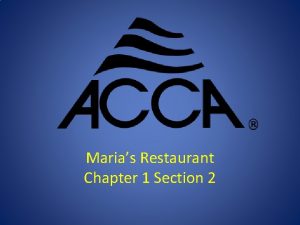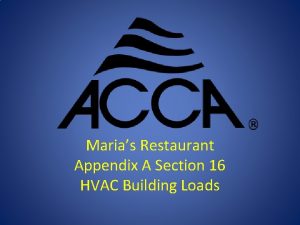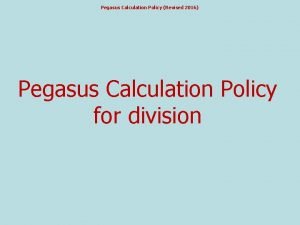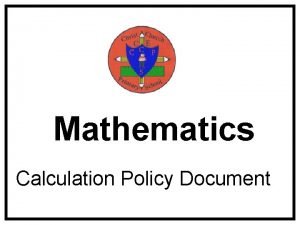Lesson 24 Appendix F Outside Air Calculation Marias
































- Slides: 32

Lesson 24 Appendix F Outside Air Calculation

Maria’s Restaurant Maria’s

Maria’s Restaurant Design Shelving/Storage Fry CT/O 25 ft. 1 standard Shelv. C 2 S 1 SP C 3 SK WH R 2 F 2 S 1 1 handicap B 2 1 urinal B 1 S 3 Bar Men’s Restroom Bar 12 X 10 Seating 12 R 4 Restaurant 33 X 15, 11 X 4 & 11 X 6 Seating 58 H 1 Kitchen Area = 533 Sqft Woman Rest Room = 110 Sqft Bar Area = 180 Sqft Dinning Area = 605 Sqft 66 ft. Bar Area = 180 Sqft Men Rest Room = 99 Sqft Entry Area = 120 Sqft Counter F 1 Shelv. . R 1 C 1 DW Woman’s Restroom S 2 1 handicap C 7 Ice C 6 R 3 (Staff: Maria & 6 Employees each shift. Glass Store Front and front door)

Restaurant Exhaust and Outside Air For Maria’s Restaurant, the Restaurant and Bar it Was decided that Class 2 air from the restaurant area would be used to condition the bathroom areas. Thus, a larger than required exhaust system for the bathrooms was used.

Operational Outside Air Minimums Air Classification Definitions from ASHRAE 62. 1 Class 1: Air with low contaminant concentration, low sensory-irritation intensity, and inoffensive odor. (May be Recirculated to any space. ) Class 2: Air with moderate contaminant concentration, mild sensory-irritation intensity, or mildly offensive odors. Class 2 air also includes air that is not necessarily harmful or objectionable but that is inappropriate for transfer or recirculation to spaces used for different purposes. (Can be recirculated to any space except a class 1 space. )

Operational Outside Air Minimums Air Classification Definitions from ASHRAE 62 Class 3: Air with significant contaminant concentration, significant sensory-irritation intensity, or offensive odor. (Can only be recirculated in space of origin. ) Class 4: Air with highly objectionable fumes or gases or with potentially dangerous particles, bioaerosols, or gases, at concentrations high enough to be considered harmful. (Can not be recirculated in space of origin or transferred. )

ASHRAE 62. 1 Outside Air Minimums Class 2 Air For a Restaurant or Kitchen 7. 5 CFM person Air Rate RA CFM/Ft 2: • 0. 12 for Kitchens • 0. 18 for Restaurants & Bars

ASHRAE 62. 1 Outside Air Minimums 2015 IMC Class 2 Transfer Air “ 403. 2. 2 air. Except where recirculation from For spaces a Restaurant or Kitchen CFM per such is prohibited by Table 7. 5 403. 3. 1. 1, airperson Transferred from occupiable spaces is not prohibited 2: air for required exhaust from serving makeup Air Rate RAas CFM/Ft systems such spaces as kitchens, baths, toilet rooms, • 0. 12 infor Kitchens elevators and. Restaurants smoking lounges. The amount of transfer • 0. 18 for & Bars air and exhaust air shall be sufficient to provide the flow rates as specified in Section 403. 3. 1. 1. ”

2015 IMC 403. 3. 1. 1 Table: 1 ft 3 of air per square foot: • Woman’s Room 110 ft 2 X 1 CFM = 110 CFM • Men’s Room 99 ft 2 X 1 CFM = 99 CFM Note: As per design values, 200 CFM per bathroom for ventilation and comfort cooling/heating is transferred from the restaurant area through Jump Ducts.

10 ACH (Required by Some Codes) • Woman’s Room 110 ft 2 X 8 ft. X 10 = 8, 800 CFH 8, 800 ÷ 60 = 147 CFM • Men’s Room 99 ft. 2 X 8 ft. X 10 = 7, 920 CFH 7, 920 ÷ 60 = 132 CFM Note: As per design values, 250 CFM per bathroom for ventilation and comfort cooling/heating is transferred from the restaurant area through Jump Ducts.

ASHRAE 62. 1 Outside Air Minimums Local Code CFM Outside Air Requirement: Restaurant & Bar Areas Zone 1 Fresh Air Requirement 74 People x 7. 5 = 555 CFM 1, 117 ft 2 Rest. x 0. 12 = 134 CFM Total Fresh Air CFM Required = 689 CFM Kitchen Area Zone 2 533 ft 2 kitchen x 0. 18 = 96 CFM Fresh Air Requirement 3 People x 7. 5 = 23 CFM Total Fresh Air CFM Required = 119 CFM

ASHRAE 62. 1 Outside Air Minimums Local Code CFM Outside Air Requirement: Restaurant & Bar Areas Zone 1 Fresh Air Requirement 74 People x 7. 5 = 555 CFM 1, 117 ft 2 Rest. x 0. 12 = 134 CFM Total Fresh Air CFM Required = 689 CFM Kitchen Area Zone 2 533 ft 2 kitchen x 0. 18 = 96 CFM Fresh Air Requirement 3 People x 7. 5 = 23 CFM Total Fresh Air CFM Required = 119 CFM

ASHRAE 62. 1 Outside Air Minimums Local Code CFM Outside Air Requirement: Restaurant & Bar Areas Zone 1 Total Fresh Air CFM Required = 689 CFM Kitchen Area Zone 2 Total Fresh Air CFM Required = 119 CFM Outside air required for Zone 1 the restaurant side of the building is 689 CFM: Thus 689 CFM must be brought into Zone 1 at all times. Note: (119 CFM into Zone 2)

Operational Outside Air Minimums Outside air required for the restaurant side of the building is 689 CFM: Thus, 689 CFM will be brought In at all times. 500 CFM will be exhausted through the two restrooms. That will mean an extra 189 CFM of air in the restaurant area. This extra air will provide a slightly positive pressure so, all air leakage from the Dinning area is into the kitchen or bathroom areas. Since the restaurant area air is Class 2 this is allowable.

Operational Outside Air Minimums Air Classification Definitions from ASHRAE 62 Food & Beverage Service Air Classification Dining Rooms 2 Cafeteria, fast food 2 Bars, cocktail lounges 2 Kitchens (cooking) 2

Kitchen Exhaust Requirements Typical Type 1 Exhaust Hood With Perforated Perimeter Supply (11. 5 ft. linear length 3, 450 CFM hood with 1, 150 CFM untempered ASHRAE 62 Class 1 makeup air)

Kitchen Exhaust Total Cooking Hood: Dish washer Hood: Total: 3, 450 CFM 600 CFM 4, 050 CFM

Operational Outside Air Minimums Outside air required for the kitchen side of the building by ASHRAE 62. 1 is 119 CFM: Thus, 119 CFM must be brought in at all times. 4, 050 CFM will be exhausted through the two kitchen exhaust hoods. That will leave a negative 3, 931 CFM of air if only 119 CFM is brought in from the outside. Thus, an additional 3, 931 CFM of air will need to be brought into the kitchen if it is to remain at a neutral pressure with respect to the outside. (slightly positive to the outside is preferable)

Kitchen Exhaust & OA Sketch AIR In 1, 150 CFM EX. AIR In 600 CFM #2 Package Heat Pump ERV EX. AIR EX 1 AIR In 500 CFM EX 2 Supply Air 3, 200 CFM AIR In Setting 1: 1, 900 CFM Setting 2: 100 CFM EX AIR OUT 500 CFM 2 Bathrooms Airflow ½ each Return Air EX 2 AIR 600 CFM Setting 1: 1, 300 CFM EX AIR Speed/Setting 1: 3, 450 CFM Speed/Setting 2: 1, 650 CFM Setting 2: 3, 100 CFM Kitchen Area (+0. 001” IWC) Bar & Dining Area (+0. 004” IWC)

The Total CFM Requiring heating and cooling Kitchen Exhaust Total is Lowered to: 4, 050 – 1, 400 = 2, 650 Cooking Hood: Dish washer Hood: Total: 3, 450 CFM 600 CFM 4, 050 CFM Bring 1, 500 CFM into the hood by a separate outside air fan. Bring 500 CFM into kitchen area from Bathroom ERV.

ERV Savings for Cooling An ERV will be used as the exhaust fan in the two bathrooms. The 500 CFM of outside air will be provided to open area over the rear entrance door. This will save about 2/3 ton of cooling requirement for the required ventilation air. Note: tonnage savings based on plugging the difference into Manual N calculations for comparison.

Dining & Bar Exhaust & OA Sketch AIR In 500 CFM ERV EXHAUST AIR 500 CFM AIR In 500 CFM Kitchen Area (+0. 001” IWC) # 1 Package Heat Pump EXHAUST AIR 500 CFM 2 Bathrooms Airflow ½ each Supply Air 2, 400 CFM Bar & Dining Area (+0. 004” IWC) Return Air 1, 711 CFM AIR In 689 CFM

ERV

500 CFM IN (BLUE) & 500 CFM OUT (Brown) Fresh Air To Building Air To Outside Blower Wheel Separated Air Paths Through Heat Transfer Media Blower Wheel MERV 8 FILTER Filter Building Air To Outside Air To Building

ERV TRANSFER EFFECIENCY 500 CFM WINTER TOTAL = 70%

ERV TRANSFER EFFECIENCY 500 CFM SUMMER TOTAL = 60%

ERV TRANSFER EFFECIENCY 500 CFM SUMMER SENSIBLE = 75%

ERV LOAD IMPLICATIONS Winter 500 CFM × 0. 70 = 350 CFM 500 – 350 = 150 CFM Thus, there is an additional 150 CFM of outside air being brought in resulting in slightly less than a 4% increase in total load or 4, 290 BTUH

ERV LOAD IMPLICATIONS Summer Total Load 500 CFM × 0. 60 = 300 CFM 500 – 300 = 200 CFM Thus, there is an additional 200 CFM of outside air being brought in resulting in slightly less than a 3% increase in total load or 3, 268 BTUH

Makeup Air Fan For Type I Exhaust The Type I hood selected is designed to have a portion of the outside air come directly into the hood untempered under full operational load. The amount in the design is 1, 150 CFM. This will save a little under 1. 5 tons of cooling requirement for the required ventilation air.

Further Savings: Two Speed Type I Exhaust Hood The Type I hood selected is designed with an automated control that senses usage. When there is no cooking station usage, hood fan lowers it’s speed so only 1, 650 CFM are being exhausted by the hood when the cooking equipment is not being used. The hood makeup fan’s 1, 150 CFM plus the 500 CFM from the ERV then meets the total hood requirement of 1, 650 CFM (1, 150 + 500). This will allow the HVAC system to save over 2 tons of cooling load for the required ventilation air, during off peak operation.

Field Notes On many occasions those who know the current outside air code requirements will try to enforce them on existing buildings. Technicians need to find out what the code was when the building was built because the equipment was designed to meet that requirement. Often the equipment is sized so it can not be adjusted to meet a new code requirement. The good news is, if the original code requirement is known, that is what must be met. In simple old fashioned terms: one horse can not pull a two horse load up a hill.
 Michael marias
Michael marias O sentimento dum ocidental noite fechada
O sentimento dum ocidental noite fechada Vuggevise tekst
Vuggevise tekst Air higroskopis adalah
Air higroskopis adalah Natural ventilation calculation
Natural ventilation calculation Air quality index calculation
Air quality index calculation Estimating air conditioning load software
Estimating air conditioning load software Air hujan sanggup menjadi air tanah lantaran proses …
Air hujan sanggup menjadi air tanah lantaran proses … Pelarut anorganik contoh
Pelarut anorganik contoh Memory valve in pneumatic
Memory valve in pneumatic Chapter 12 section 1
Chapter 12 section 1 Can you feel it in the air in the air
Can you feel it in the air in the air An air mass is created when a large body of air
An air mass is created when a large body of air Two cold air masses converge on a warm air mass
Two cold air masses converge on a warm air mass Put your left hand in
Put your left hand in All kinds of shapes
All kinds of shapes Return air and supply air
Return air and supply air Right hand in the air left hand in the air
Right hand in the air left hand in the air Air payau adalah campuran
Air payau adalah campuran Two pass shell and tube heat exchanger
Two pass shell and tube heat exchanger Cold front air movement
Cold front air movement Air masses & frontswhat is an air mass?
Air masses & frontswhat is an air mass? Actual air refrigeration system
Actual air refrigeration system A shuttle valve exhausts an air pilot of a dcv when
A shuttle valve exhausts an air pilot of a dcv when Two pressure valve symbol
Two pressure valve symbol The boundary between two adjacent air masses is called
The boundary between two adjacent air masses is called Hail
Hail Denah sanitasi air kotor
Denah sanitasi air kotor A swirling center of low air pressure is called
A swirling center of low air pressure is called Chapter 12 air section 1 what causes air pollution
Chapter 12 air section 1 what causes air pollution Cold air mass overtakes warm air mass
Cold air mass overtakes warm air mass Air masses & frontswhat is an air mass?
Air masses & frontswhat is an air mass? Air masses & frontswhat is an air mass?
Air masses & frontswhat is an air mass?
